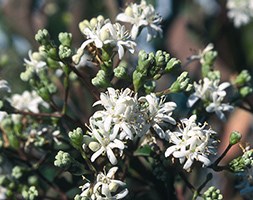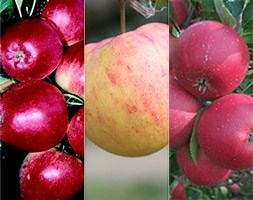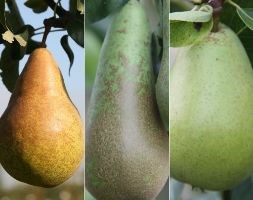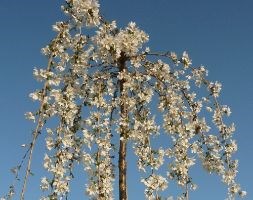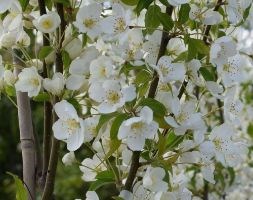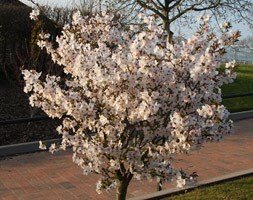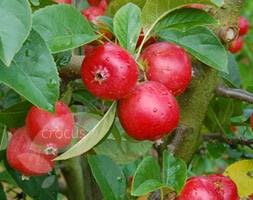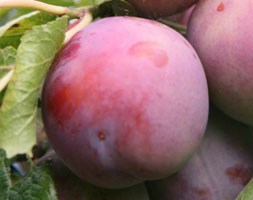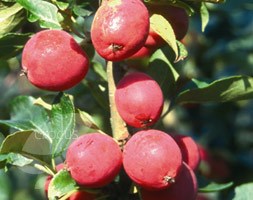New products at Crocus
by Sarah - October 11th, 2015.Filed under: Crocus, New Products.
Crocus just added these new items
Heptacodium miconioides (seven son) £84.99
Position: full sun or light dappled shade Soil: moist but well-drained, neutral to acidic soil Rate of growth: average to fast Flowering period: September to November Flower colour: creamy-white Other features: the pinkish-red calyxes can remain on the plant for a couple of months Hardiness: fully hardy Clusters of scented, creamy-white flowers appear at the ends of the branches from late summer, and long after they have fallen, the pinkish-red calyxes often remain colourful, deepening to rich burgundy as they age. When not in flower the deciduous leaves are attractive in their own right. Lustrous green and deeply veined, they hang in elegant pairs along the branches, usually become tinged with claret before they fall. A member of the honeysuckle family, this multi-stemmed shrub or small tree is loved by butterflies and makes a stylish and unusual addition to the garden. Garden care: When planting incorporate lots of well-rotted garden compost in the planting hole and stake firmly. Requires minimal pruning.
apple ‘cox self fertile / James Grieve / Katy’ (family apple) £79.99
Position: full sun Soil: fertile, well-drained soil Rate of growth: average to fast-growing Ultimate size on MM106 rootstock: 5.5 x 5.5m (18 x 18ft) Flowering period: April and May Other features: delicious dessert apples Hardiness: frost hardy (may need winter protection, particularly in colder parts of the country) Pollination Group: C – flowering late season Family apple trees are ideal where space is limited as there is no need to worry about pollination partners and you can pick several different varieties from the same tree. On this fab family tree, there are three grafted branches, each branch will produce one of the following varieties: ‘Cox’s Self Fertile’ – this is regarded by many as one of the best eating apples. They have a superb flavour and sweet aroma with deep creamy flesh. Ready to harvest in October. ‘James Grieve’ – producing crisp and juicy, red-flushed, green apples that have remained comnsitenetly popular since they were first introduced in 1893. A reliable cropper, the apples can be used for cooking or eating and can be harvested from September. ‘Katy’ – a recent introduction that is proving popular for its heavy crop of bright red fruits, which have a firm, juicy flesh with just the righ balance between sweet and acid. Excellent for juicing and making cider. Garden care: Keep the base of the tree weed free, fertilise at the beginning of each year and water regularly during hot, dry spells. Remove damaged or crossing branches during the dormant season. Pollination Information: As these trees are made up of several different varieties that can cross pollinate freely, you will not need another pollinating partner.
pear ‘Doyenne‚ Du Comice’ / ‘Conference’ / ‘Concorde’ (pear – family) £74.99
Position: full sun Soil: fertile, well-drained soil Rate of growth: average Flowering period: April Flower colour: white Other features: delicious dessert pears Hardiness: fully hardy Pollination Group: B & C – flowering mid and late season Root Stock: Qunice ‘A’ Three different types of pears have been grafted onto this ‘family’ tree, which will bear a sucession of fruit from late summer to mid autumn. The chosen varieties will all cross pollinate freely, so there is no need to plant another tree nearby, making it particularly useful for smaller gardens. This tree has been grafted with the following varieties – ‘Doyenne Du Comice ‘ – an outstanding pear, which is renowned for its flavour, texture and taste. Ready to harvest in mid October. ‘Conference’ – the pure white flowers of this dessert pear are followed by delicious, long, yellowish green fruits in late September. A popular choice in the UK as it copes well with adverse conditions better than most. ‘ Concorde’ – a reliable cropping variety producing tasty, juicy, yellow skinned fruits late in the season. The white flowers in spring are also pretty. Garden care: Pears naturally shed a small quantity of the developing fruits in mid summer. After this has occurred thin out the remaining pears, leaving one pear per cluster. Apply a high-nitrogen feed in spring. Pollination Information: As these trees are made up of several different varieties that can cross pollinate freely, you will not need another pollinating partner.
Prunus ‘Snow Showers’ (weeping Fuji cherry (syn. ‘Hillings Weeping’)) £74.99
Position: full sun Soil: tolerates most soils Rate of growth: average Flowering period: March to April Flower colour: white Other features: retains its shape well Hardiness: fully hardy The cascading crown of this miniature tree has been grafted onto a straight, upright stem measuring 90cm tall. Its branches are laden with single, white flowers in early spring – just before the leaves start to emerge. This prolific display is impressive, as is the trees ability to maintain its compact form, making it particularly suitable for smaller gardens. It can also be potted up into a large container and kept on a sunny terrace, where you can enjoy the spectacle close-up. The autumn colours the leaves turn before they drop are pretty good too! Garden care: When planting incorporate lots of well-rotted garden compost in the planting hole and stake firmly. Prune in summer to reduce the risk of silver leaf and bacterial canker. Cut back any dead, diseased or branches which cross to healthy wood.
Malus brevipes ‘Wedding Bouquet’ (crab apple) £74.99
Position: full sun or partial shade Soil: fertile, well-drained soil Rate of growth: average Flowering period: May Flower colour: white Other features: small dark red fruits Hardiness: fully hardy A very pretty crab apple, that makes an excellent addition to smaller gardens. In spring, it produces a mass of ivory white flowers, just as the fresh green leaves start to appear. From late summer, these are followed by dark red fruits, which remain until well into winter. Perfect for a small garden or large pot. Garden care: When planting incorporate lots of well-rotted garden compost in the planting hole and stake firmly. Removed dead, diseased and crossing branches while the tree is dormant.
Prunus ‘The Bride’ (ornamental cherry) £69.99
Position: full sun Soil: tolerates most soils Rate of growth: average Flowering period: April Flower colour: white Hardiness: fully hardy The flowers of this small, rounded tree are exquisite, and create a wonderful display in mid-spring. Larger than many of the other ornamental cherries, they have pure white petals, which surround a contrasting cluster of distinctive red anthers. The dense, twiggy crown of this small tree has been grafted on to the upright stem of the rootstock at a height of 45cm, so it will make a fine specimen for a lawn or spring border where it can be underplaned with bulbs. In autumn, the normally green leaves turn rich autumn shades before they drop. Garden care: When planting incorporate lots of well-rotted garden compost in the planting hole and stake firmly. Prune in summer to reduce the risk of silver leaf and bacterial canker. Cut back any dead, diseased or branches which cross to healthy wood.
Malus ‘Rosehip’ (crab apple) £64.99
Position: full sun or partial shade Soil: fertile, well-drained soil Rate of growth: average Flowering period: May Flower colour: white Hardiness: fully hardy Recently introduced, the rounded, red fruit of this fine, small tree have pronounced calyces, which (as the name suggests), makes them look like rosehips. The white flowers that appear in late spring put on a good show too. Perfect for smaller gardens, they provide interest off and on throughout the year and will never get too large and unmanageable. Garden care: When planting incorporate lots of well-rotted garden compost in the planting hole and stake firmly. Removed dead, diseased and crossing branches while the tree is dormant.
plum ‘Marjorie’s Seedling’ (plum) £64.99
Position: full sun Soil: will tolerate most soils, except very chalky or badly drained Rate of growth: slow growing Ultimate size on VVA1 rootstock: 3 x 3m (10x10ft) Ultimate size on St Julien rootstock: 4 x 4m (13x13ft) Flowering period: April to May Flower colour: white Other features: top quality culinary or dessert plum (late September) Hardiness: fully hardy An upright, vigorous tree which produces large, sweet purple plums late in the season. It is a popular variety that has cup-shaped white flowers later than most, reducing the risk of the blossom being killed by late frosts. The versatile fruit can either be eaten fresh or used for cooking, and is fairly juicy with yellow flesh. It is a self-fertile tree that is wonderful plum for a small garden. Garden care: When planting incorporate lots of well-rotted garden compost in the planting hole and stake firmly. Prune in summer to reduce the risk of silver leaf and bacterial canker.
Malus x robusta ‘Dolgo’ (crab apple (syn Pink Glow )) £64.99
Position: full sun or partial shade Soil: fertile, well-drained soil Rate of growth: average Flowering period: May Flower colour: white Other features: rounded, pink fruits Hardiness: fully hardy This is the tree to buy if you dont just grow crab-apples for their late spring flowers, as the larger than average fruits of ‘Pink Glow’ appear earlier than most, and are one of the best for making jellies and jams. That is not to say that the prolific display the simple white flowers provide is anything less than fabulous. This round-headed tree, grows to a manageable size, so it can be grown in smaller gardens, and because of its two main seasons of interest, it makes an excellent specimen. Garden care: When planting incorporate lots of well-rotted garden compost in the planting hole and stake firmly. Removed dead, diseased and crossing branches while the tree is dormant.







